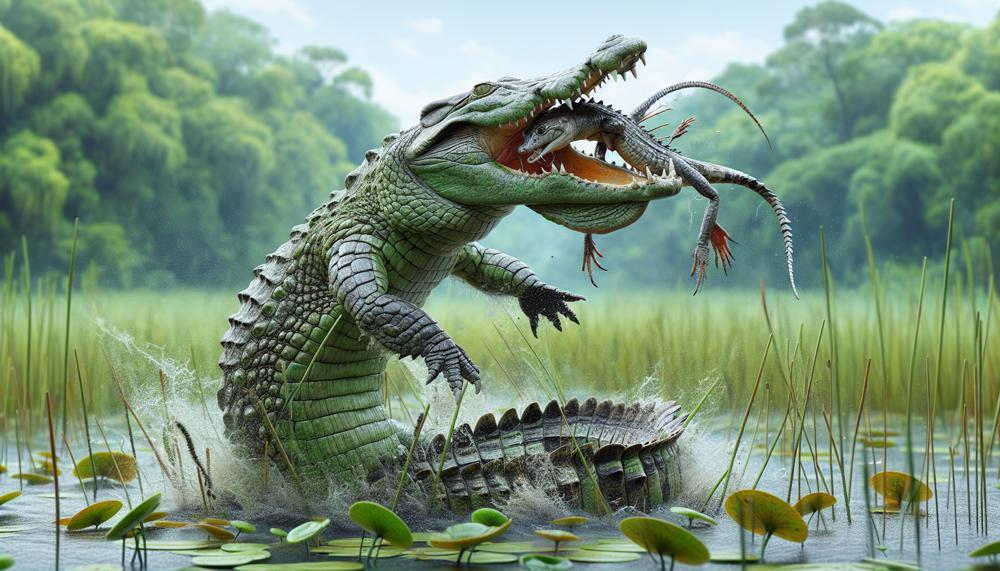Imagine a being who is both feared and adored, a master of its realm, whose ancestry dates back to the period of dinosaurs. Looming in the waters of rivers, lakes, and mangroves, crocodiles are the pinnacle of these creatures.
For millennia, people have been both captivated and confused by their eating habits.
We’ll delve into the world of crocodiles in today’s article and unravel the secrets of their eating habits.
Ever wonder how these extinct creatures make ends meet in the wild? Get ready to get all of your questions answered as we delve into the specifics of crocodile cuisine. You may be surprised to learn about their true eating habits despite their intimidating image.
In this article, we will unravel:
- The frequency of crocodile meals and the factors influencing their dining schedule
- The diversity of their diet and how it changes as they grow
- The strategic methods crocodiles employ to hunt and secure their food
- The impact of their feeding behavior on the ecosystem
Join us on an enthralling journey into the world of these fascinating reptiles. You’ll emerge with a newfound understanding of their place in the natural order, and perhaps, a greater appreciation for the complexity of their existence.
Contents
Crocodile Species and Their Habitats
Crocodiles are found in a diverse range of habitats, each species adapted to its unique environment. Here’s a brief overview:
| Species | Habitat | Region |
| Saltwater Crocodile | Estuaries, mangroves, river mouths, coastal areas | Asia-Pacific region |
| Nile Crocodile | Freshwater rivers, lakes, marshlands | Sub-Saharan Africa |
| American Crocodile | Brackish waters, mangroves, rivers, coastal areas | North, Central, and South America |
| Dwarf Crocodile | Forested rivers and swamps | West Africa |
Influence of Habitat on Feeding Habits
The habitat of a crocodile species directly influences its diet and feeding frequency.
- Saltwater Crocodile: Thriving along shores and in brackish waters, these crocs have a diet including a vast array of sea creatures like crabs, turtles, and occasionally sharks. Their coastal habitat allows them to exploit both land and sea food resources.
- Nile Crocodile: Inhabiting the rivers of Africa, Nile crocodiles consume fish as a staple, but they also ambush land animals that come to drink. Their riverine environment provides a rich selection of prey, from aquatic species to unsuspecting terrestrial creatures.
- American Crocodile: Found in a mix of saltwater and freshwater, their varied diet includes fish, small mammals, and birds. The overlap of marine and riverine prey types in their habitat offers a diverse buffet for these reptiles.
- Dwarf Crocodile: Preferring forested waterways, they primarily feed on small fish, amphibians, and invertebrates. The dense vegetation of their habitat provides ample hiding spots for ambushing prey and a diet rich in smaller, more accessible creatures.
Crocs are apex predators, and their habitats provide diverse opportunities for hunting. Their slow metabolism and ectothermic nature mean they don’t need to feed often, but when they do, they are masters of their domain, using their environment to their advantage to secure a meal. Younger crocs have a higher metabolic rate and thus hunt more frequently than their elders, who might feast less often but on larger prey.
Their habitats not only offer them a variety of food sources but also influence their hunting strategies and periods of activity. For instance, during colder seasons or in times of food scarcity, crocodiles can slow down their metabolism and enter a state of dormancy, conserving energy until conditions improve.
Crocodile Diet and Hunting Techniques
Crocodile Diet
Crocodiles are known as the formidable lurkers of the waterways, preying with a diet as diverse as the ecosystems they dominate. They fancy a smorgasbord of critters, including:
- Small mammals: Creatures like rodents or monkeys might find themselves on the menu.
- Birds: Feathered prey isn’t safe near these toothy beasts.
- Fish: A staple in the crocodile’s diet, particularly for species dwelling in rivers and estuaries.
- Bugs: Even insects aren’t too small for a croc’s mealtime.
- Frogs: These amphibians are easily snatched up when crocodiles are about.
- Other reptiles: Smaller, less dominant reptiles can become a part of their diet.
- Crustaceans: For those crocs who favour coastal habitats, crustaceans are a crunchy delight.
Hunting Techniques
In the art of the ambush, crocodiles are the undisputed masters. They blend into their watery realms, scarcely a ripple to reveal their presence, and then snap. Dinner is served. Their hunting arsenal includes:
- Stealth: Crocs are like submerged ninjas, silently approaching their quarry.
- Distraction: They’re crafty, using the element of surprise to their advantage.
- Drowning: They drag their catch under the waves to seal the deal.
- Mighty Jaws: With a bite force to write home about, their grip is inescapable.
Meal Frequency
Crocodiles don’t stick to a nine-to-five dining schedule. They eat when the opportunity knocks, which can vary greatly depending on their habitat’s buffet and their own monstrous size. Here’s a snapshot of what a crocodile’s typical dining table might look like:
| Prey Type | Examples | Frequency Notes |
| Small mammals | Rodents, monkeys | As they come by |
| Birds | Ducks, storks | When in proximity to nests or during migration |
| Fish | Catfish, mullet | Regular meals, depending on water conditions |
| Bugs | Beetles, dragonflies | Snacks, more common for younger crocs |
| Frogs | Various species | Seasonal feasts, especially during mating seasons |
| Other reptiles | Snakes, smaller crocodiles | Occasional, when territory is challenged |
| Crustaceans | Crabs, shrimp | Coastal crocs indulge when tides are right |
Feeding Behavior of Crocodiles Through Life Stages
Crocodiles exhibit a fascinating progression in their feeding habits as they advance from hatchlings to imposing adults. Their diet evolves, reflecting their growing size and predation capabilities.
Hatchlings:
| Prey | Feeding Technique | Frequency |
| Small invertebrates (insects, crustaceans) | Snapping and chasing | Multiple times daily |
Juveniles:
| Prey | Feeding Technique | Frequency |
| Birds, small mammals, larger invertebrates | Ambush and quick strikes | Regularly as opportunity arises |
Adults:
| Prey | Feeding Technique | Frequency |
| Fish, birds, mammals, reptiles, carrion | Stealthy ambush, powerful grip | Less frequent, large meals |
As hatchlings, crocodiles focus on tiny creatures they can easily overpower. Their diet consists primarily of water-dwelling invertebrates, supplementing their yolk-sac nutrients.
Moving on to juvenile status, they start tackling more substantial prey. Their growing bodies demand more energy, and they begin to exhibit the ambush strategies characteristic of their species.
Adult crocodiles are the apex predators of their domains. They consume a wide array of prey, from fish to zebras, depending on availability. Adults can exert patience, lying in wait for the perfect moment to launch an attack.
Cannibalism is a stark reality in the world of crocodiles, particularly when food is scarce. Younger crocs might fall victim to their larger counterparts.
Crocodile feeding is sporadic; these creatures can survive extended periods without a meal thanks to their slow metabolism. They’re known to store food underwater for lean times.
Their diet is influenced by seasonal changes, with a preference for fish during rainy months. Despite their ferocity, crocodiles maintain a balance within their ecosystems, preventing overpopulation of certain species.
Safety Note: While attacks on humans are infrequent, they occur. It’s crucial to remain vigilant near crocodile habitats to avoid mistaking us for a snack.
Physical Attributes of Crocodiles Aiding Their Feeding Habits
Crocodiles are formidable apex predators, and their physical characteristics are finely tuned to make them proficient hunters. Let’s dive right in and dissect these features:
Jaw Strength and Size
Crocodiles possess immensely powerful jaws, with a bite force that can reach a staggering 3,000 pounds per square inch. This raw power allows them to clamp down on and immobilize large prey with ease.
Body Size
Their considerable body mass and size enable them to tackle substantial prey, potentially even larger than themselves, a testament to their prowess in their watery domains.
Protective Skin
The tough, armoured skin of a crocodile not only serves as a shield against the struggles of the wild but also works as insulation, crucial for a cold-blooded creature in regulating body temperature.
Sensory Adaptations
Crocodiles have a long, narrow snout packed with sensory receptors, a toolkit for detecting the slightest vibrations in the water, signaling the presence of potential prey nearby.
Digestive Efficiency
These reptiles have a unique four-chambered stomach that ensures they extract maximum nutrients from their food, a design that could put the most advanced food processor to shame.
Metabolic Advantage
Owing to their cold-blooded metabolism, crocodiles need less fuel than warm-blooded animals of a similar size, allowing them to thrive in diverse habitats with varying food availability.
Survival without Food
Their slow metabolism is an ace up their sleeve, letting them go for extended periods between meals without compromising their status as top predators.
Crocodile Metabolism and Digestion
Crocodiles are remarkable creatures that have evolved to thrive in environments where meals can be few and far between.
Their ability to survive on limited food intake and extended periods without eating is owed to their specialized metabolism and digestive system.
Metabolic Efficiency
Crocodiles benefit from being ectothermic (cold-blooded), meaning they don’t need to consume as much food as endotherms (warm-blooded animals) to maintain their body temperature. This allows them to sustain longer intervals between meals.
Digestive Mastery
The crocodile’s digestive system is a marvel of nature, designed to wring every ounce of nutrition from its prey. The four-chambered stomach ensures that digestion is both thorough and efficient.
Adapted Diet
These apex predators have a varied diet and can consume large prey due to their formidable jaws and size. Their opportunistic diet includes:
- Fish
- Birds
- Mammals
- Smaller crocodiles
- Carrion
- Occasional plant matter and gastroliths (rocks to aid digestion)
Survival Tactics
Crocodiles have adapted to their surroundings to become supreme survivalists, often lying in wait for unsuspecting prey. Their capability to stay motionless and patient reduces their energy expenditure.
Table of Digestive Adaptations
| Feature | Function | Survival Benefit |
| Slow metabolism | Reduces energy needs | Longer periods without food |
| Four-chambered stomach | Efficient nutrient extraction | Maximizes energy from meals |
| Powerful jaws | Can take down large prey | Less frequent need to hunt |
| Opportunistic feeding | Scavenge a wide range of food sources | Adaptability in scarce times |
The crocodile’s metabolism and digestion are fine-tuned to ensure survival even when the pickings are slim. Conservation efforts are key to safeguarding these creatures, ensuring they continue to play their crucial role in the ecosystem. Despite their fearsome nature, they seldom see humans as prey and incidents involving humans are exceptional.
Threats and Conservation
Crocodiles face a slew of threats, many of which stem from human activities. Here’s a breakdown of some of the primary dangers these ancient reptiles encounter:
- Habitat Loss: Expanding urbanization and agriculture are shrinking and fragmenting the wetlands that crocodiles call home.
- Illegal Trade: A lucrative black market for crocodile skin and other body parts fuels poaching and illegal hunting.
- Climate Change: Altered weather patterns and sea level rise threaten nesting sites and alter freshwater habitats.
- Pollution: Contamination of water bodies can lead to health issues for crocodiles and affect their reproductive success.
- Human Conflict: As human populations expand, encounters with crocodiles can lead to retaliatory killings.
Conservation Efforts for Crocodiles
To combat these threats, conservationists, governments, and local communities are rallying together. The following table highlights key conservation actions:
| Conservation Action | Description | Impact |
| Protected Areas | Establishment of wildlife reserves and sanctuaries. | Provides safe habitats, free from human-led disturbances. |
| Regulation of Trade | Implementation of laws like CITES to control the trade of crocodile products. | Reduces poaching and illegal market demand. |
| Community Engagement | Education programs and involving locals in ecotourism and conservation projects. | Increases public support and provides economic benefits that incentivize protection. |
Unusual Dietary Habits
Crocodiles are known for their voracious appetites and aren’t fussy about their meals. Their unusual dietary habits extend beyond the expected menu of meat and fish, illustrating their adaptability and survival instincts.
Here’s a peek into the curious culinary choices of these formidable reptiles:
Opportunistic Feasting:
Crocodiles will gobble up whatever they can snag. This includes surprising items like stones, which they swallow to grind up food in their stomachs—a bit like a bird’s gizzard stones.
Unexpected Snacks:
In a pinch, crocs aren’t averse to munching on vegetation or their own offspring’s eggs. While it might seem counterintuitive, this provides a vital nutrient boost, especially when meat is scarce.
Cannibalistic Cravings:
Size doesn’t deter these creatures; they’ve been known to prey on smaller crocodiles. It’s a tough world out there, and crocs take the term ‘survival of the fittest’ very seriously.
Scavenging Specialists:
Crocodiles will happily scavenge carrion. Whether it’s leftovers from another predator’s feast or an unfortunate creature that didn’t make it, crocs aren’t picky about freshness.
| Unusual Diet Component | Reason for Consumption | Frequency |
| Stones | Aids digestion | Occasional |
| Vegetation | Nutrient supplement | More common in captivity |
| Own eggs | Source of nutrition | Rare |
| Smaller crocodiles (Cannibalism) | Food scarcity/Opportunistic | Uncommon but observed |
| Carrion | Easy meal/Opportunistic | Common |
Conclusion
Crocodiles are seasoned actors in the predator-prey ballet, their long pedigree molding a nutritional discipline as intricate as it is interesting.
Our exploration of the world of crocodiles has shown us that, contrary to popular belief, these powerful creatures eat rather seldom. This is because they have an ectothermic metabolism, which enables them to feast efficiently on occasion.
Their eating strategies are a patchwork of evolutionary genius, from the sly hatchling snatching tiny invertebrates to the majestic adults controlling streams with strong ambushes.
As we’ve discovered, habitat has a significant influence on the kind of food that crocodiles choose to eat. While some species, like the American and dwarf crocodiles, are equally adept at navigating their more specialized settings, others, like the saltwater and nile crocodiles, feed on a wide variety of substrates. Their varied diet, which includes both fish and animals, as well as their creative hunting strategies, attest to their versatility, which has allowed them to survive for millennia.
Crocodiles get older and go from eating tiny prey often to eating bigger meals less frequently. This change is a reflection of their increasing size and strength as well as an underlying energy-saving efficiency that is essential to their existence.
In conclusion, crocodiles are calculating and opportunistic predators rather than the ravenous monsters of mythology, with feeding frequency that vary widely with age, habitat, and prey availability. keeping these ancient animals and their habitats is vital because of their function as apex predators in keeping ecological equilibrium.






